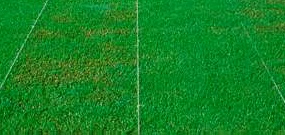Debunking endophytes
Learn about buying seed containing endophyte. An endophyte is a fungus which grows inside a plant.
Debunking endophytes
The word endophyte keeps cropping up in magazine articles, talks and in seed advertisements. Associated with it are all sorts of claims of insect resistance, stress tolerance, etc. This article will attempt to give you the facts as well as point out some precautions when buying seed containing endophyte.
What is an endophyte?
An endophyte is a fungus which grows inside a plant. The endophytes that we are most concerned with are the ones growing inside a turfgrass plant. These endophytes, unlike disease causing fungi, do not cause any harm to the turfgrass plant. Currently, endophytes have been found in tall fescue, perennial ryegrass, hard fescue, chewing fescue and creeping red fescue. There are no known endophytes occurring in Kentucky bluegrass or creeping bent grass. Endophytes are found in all parts of the plant except the roots with the highest concentration found in the leaf sheath.
Endophytes and insect tolerance
The discovery that high endophyte grasses were resistant to insect feeding was accidental. A study in New Zealand was looking at the effect of endophytes on sheep grazing. After this study it was discovered that when the tall fescue was growing in after grazing that the endophyte free tall fescue was being attacked by a grass pest called the Argentine Stem Weevil but the high endophyte plot was not attacked.
Since this chance discovery many research reports on turfgrass species containing endophytes have shown that they enhance resistance to surface feeding insects including sod webworm, bill bugs and chinch bugs. The endophyte either produces a poison or makes the plant produce a chemical which repels insects that feed on turf. Studies have shown that the amount of insect resistance is directly proportional to the percentage of endophyte living within the turfgrass plant (Figure 1).

Endophytes and stress tolerance
Endophyte enhanced turfgrasses have shown increased stress tolerance. This has been expressed by reduced weed invasion, better summer survival and fall recovery after a drought. The reasons for the enhanced stress tolerance are not well understood.
How are endophytes passed on from generation to generation?
A turfgrass plant containing endophytes will have endophytes in the leaves and sheath. When that plant goes to seed the endophytes will grow into the seed also. As long as those seeds containing the endophytes are properly stored those endophytes will remain in the seed. When that seed germinates and grows into a turfgrass plant the resulting plant will also contain the endophyte.
Effect of seed storage on endophytes
The endophytic fungus which is present in turfgrass seed at the time of harvest can lose its viability very quickly if it is not stored under proper conditions. The storage conditions necessary to maintain endophyte viability in the seed are cool dry conditions. According to some studies conducted with tall fescue at a temperature of 5°C seed containing 100% endophytic fungi can be stored up to 15 months without losing the viability of the endophytes. On the other hand endophytic seed stored at 21°C will lose 40% of its endophytes in 7 months and all of its endophytes in 11 months.
What role can endophytic turfgrasses play in turf management?
Due to the inherent insect resistance of endophytic grasses they are a useful tool in an integrated pest management (IPM) approach to turf management. Seeding with perennial ryegrass, tall fescue, hard fescue, chewing and creeping red fescue containing endophytes whenever possible, will reduce reliance on pesticides for control of above ground feeding insects. Added to this is the enhanced stress tolerance making your job as a turf manager easier. A list of turf cultivars which contain endophytes can be found in OMAFRA Publication 384, Turfgrass Management Recommendations or see Table 1. As well, information with regard to species and cultivars which contain endophytes can be obtained from your seed supplier.
| Species | Cultivars |
|---|---|
| Creeping Red Fescues | Herald Jasper E SR 5200 E |
| Chewings Fescue | Bridgeport Jamestown II Koket SR 5000 SR 5100 Treazure Southport Victory E |
| Hard Fescues | Nordic Reliant SR 3000 SR 3100 |
| Sheep Fescues | SR 3200 |
| Turf — Type Perennial Ryegrass | Accolade Achiever Affinity APM Birdie II Buccaneer Citation II Competitor Cutter Dandy Dasher II Delaware Dwarf Dimension Divine Edge Elf Elf Dwarf Envy Express Fiesta II Gettysberg Jazz Manhattan II Omega II Palmer Panther Pinnacle Prelude Premier Prizm Repell II Saturn II Seville Sovereign SR 4000 SR 4010 SR 4100 SR 4200 SR 4300 SR 4400 Stallion Stallion Select Yorktown III Wizard |
| Tall Fescue | Adobe Apache Aquara Arid Aztec Bonanza Bonsai Chieftan Coyote Empress Finelawn I Gazelle Jaguar III Mirage Mustang II Pixie Rebel 3D Rebel II Rebel Jr. SR 8200 SR 8210 SR 8300 Tribute Titan Twilight Vegas Winchester |